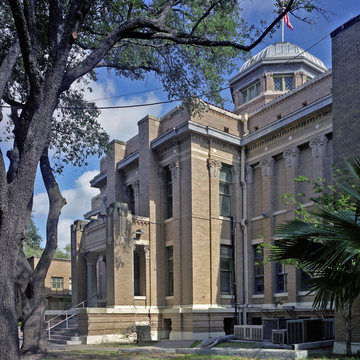The city grid of 1888, diagonally bisected from east to west by the Texas Mexican Railway line, did not originally include a courthouse square. That civic space was placed in a prime residential area when the courthouse was designed by Ayres. The style mix of Prairie with classical influences was the creation of Ayres's employee George Willis, who had served as chief draftsman to Frank Lloyd Wright from 1898 to 1902. This courthouse is the most stylistically integrated of the four on which he worked during his tenure in Ayres's office. Of note is the building's vertical emphasis with its tall, thin pilasters with Sullivanesque capitals. Originally, the paired brick piers at its four entrances protruded through the cornice and parapet and were topped by truncated pyramidal caps, which, unfortunately, were removed during the remodeling and expansion in 1948. Small-scale versions of the piers are still visible as supports for the two remaining entrance porches. That expansion project included two large modern additions in brick by Noonan of San Antonio. Placed on either side of the courthouse, the new wings nearly doubled its interior space and reflect the dramatic increase in Alice's population from 7,700 in 1940 to more than 15,000 in 1950.
The courthouse was the stage for the infamous events of the state's Democratic Party U.S. Senate primary election of 1948 between former governor Coke Stephenson and up-and-coming Lyndon B. Johnson. After the first tally of votes statewide indicated a narrow loss to Johnson, he is reputed to have requested the assistance of local party boss George Parr, who added over two hundred votes to the ballot box of Precinct 13 in Alice, giving Johnson a narrow victory and setting him on his national political career. Ironically, Parr had provided the same service to Stephenson in a previous election.





















